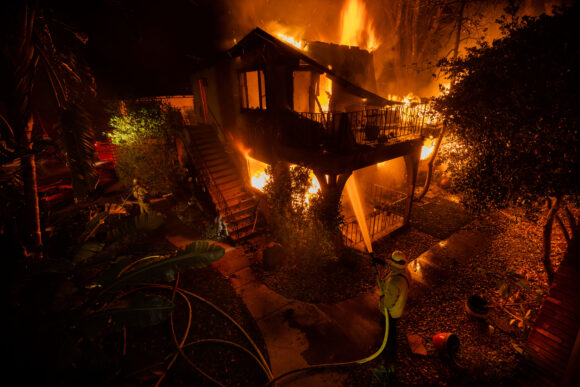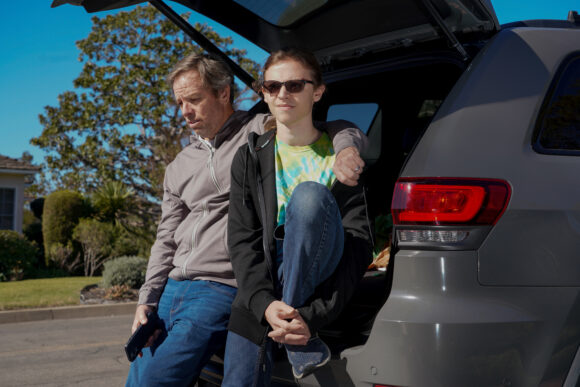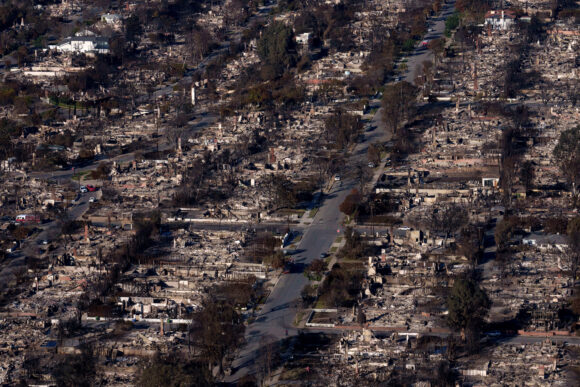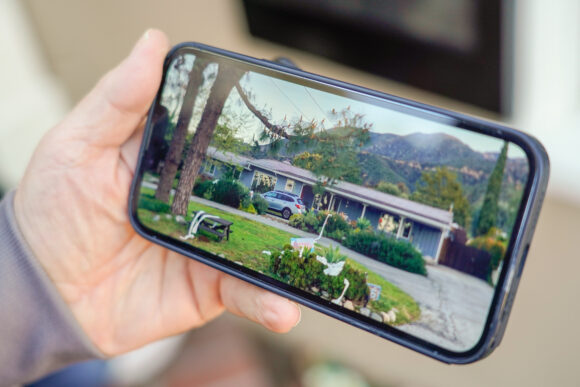California politicians are rushing to make it easier for residents to rebuild their homes incinerated in the Los Angeles firestorms. That means waiving green construction mandates designed to combat climate change — which is driving such conflagrations by making conditions hotter and drier — as well as suspending environmental reviews and promising to expedite permits.
Los Angeles Mayor Karen Bass issued an executive order on Monday to ease rebuilding nearly 3,000 houses destroyed in Pacific Palisades. The order suspends an ordinance that would have required replacement homes to be all-electric, which would have greatly reduced the use of natural gas in a high-risk fire zone.
Related: Fire-Ravaged LA to See Respite But Danger ‘Not Yet Passed’
California Governor Gavin Newsom has proposed a $2.5 billion “Marshall Plan” for LA’s recovery. On Thursday he announced an executive order fast-tracking approval of temporary housing, such as accessory dwelling units and trailers, that can be placed on burned properties so residents can return.
His office is also reviewing state building codes that could be suspended to speed rebuilding, among them a mandate that solar panels be installed on new homes.

Even climate-conscious California is willing to forego some green rules when faced with a recovery on this scale. But the need for speed must be balanced, experts say, with strengthening wildfire defenses in places that will inevitably burn again as climate impacts intensify.
“We all want to live in these beautiful but flammable landscapes,” said fire scientist Jennifer Balch, an associate professor at the University of Colorado at Boulder. “We need to look at high-risk areas and incentivize people to build in a very resilient way.”
‘We Just Want to Move Forward as Quickly as Possible’
Many displaced residents want to return. Isabel Ramirez and her husband, Mel Ramirez, cherished the avocado, orange and pine trees at their Altadena home before wildfires destroyed the property. Now, the couple is eager to rebuild both their house and the lush vegetation that once defined it.
“It was just very private, beautiful and lots of greenery,” said Isabel Ramirez, waiting to meet with Federal Emergency Management Agency staff in a community college parking lot framed by the charred San Gabriel Mountains. “We just want to move forward as quickly as possible.”

Peter Wilson is also likely to rebuild his ranch-style house nestled against the San Gabriels, one of 5,700 homes counted as lost so far in Altadena. “I don’t know where else I’d rather live,” he said — even as his teenage son urged the family to consider starting anew outside the wildfire hazard zone.
In Pacific Palisades, the city’s waiving of the all-electric requirement will give residents the option of replacing their fossil-fuel stoves, water heaters and furnaces with the same type of equipment, according to the mayor’s office.
That may well cut rebuilding costs, said J. Keith Gilless, a professor emeritus and urban wildland fire expert at the University of California at Berkeley. But those savings should be “weighed against recent evidence on the potential health hazards of natural gas, and the state’s aspirations to reduce reliance on fossil fuels,” he said. California’s plan to become carbon neutral by 2045 depends in part on transitioning households to clean energy.
Related: InsurTechs Highlight New Approaches to Wildfire Insurance
“Natural gas leaks can complicate firefighting efforts,” Gilless added.
Gas lines are buried underground, but in a fast-moving wildfire, if a gas line inside the house connected to an appliance breaks, that “could intensify a particular structure fire,” according to Alan Murray, a professor and principal investigator at the University of California at Santa Barbara’s Wildfire Resilience Initiative. “Coupled with high winds, this is not good.” Propane gas tanks used for outdoor grills and other equipment could be heard exploding as the Palisades Fire raged.
Officials say they want to give residents flexibility in how they rebuild. “We want to help you rebuild like-for-like as close as possible, if not better,” said Anish Saraiya, planning and public works deputy for Los Angeles County Supervisor Kathryn Barger, whose district includes the fire-ravaged community of Altadena. “So if you got a mid-century modern, we want to see that mid-century modern come back. If you got a Craftsman, we want to see that Craftsman come back.”
Even if they look like the homes they replace, though, the new houses will be sturdier than those from the 1920s or 1960s, since building codes now are far more stringent.

Mike Rothschild, a writer who lost his Altadena home in the Eaton fire, said he fears rebuilding will result in a “100-year-old Craftsman next to a block of condos that doesn’t belong there, next to a McMansion.”
Bass’s executive order contains a safeguard to prevent such a proliferation of supersized homes. Replacement houses in Pacific Palisades can be a maximum of 10% larger than the original under the mayor’s order. (Altadena is under the jurisdiction of Los Angeles County, which will impose the same size limits, according to a spokesperson for Barger.) The restriction also applies for Palisades homeowners to receive expedited approval from the California Coastal Commission, which has authority over the oceanside neighborhood.
Limiting the size of new homes guards against what happened in Northern California following the 1991 Oakland-Berkeley hills firestorm: There, cottages gave way to McMansions that will only add more fuel to any future fire.
Fire Hardening Won’t be Optional
Replacement dwellings in both Pacific Palisades and Altadena also must comply with state building codes that govern new construction in what California designates as “very high fire hazard severity zones.” Those regulations mandate that houses be clad in fire-resistant materials, window glass be tempered and screens be installed over vents to prevent wind-blown embers from entering the home. Decks, fences and stairs must also be fire-resistant.
A 2022 study by nonprofit research group Headwaters Economics estimated that complying with those requirements would add $26,110 to the cost of a 1,765-square-foot single family home in Southern California. The California standards, though, date from 2010, when wildfires were less frequent and less destructive. Building a state-of-the-art fire-resistant home could cost $53,190 more, according to Headwaters.
Competition for contractors, laborers and materials could further drive up the cost of rebuilding. “If we’re looking to rebuild in a sustainable, resilient way, the number of contractors that know how to do this is 1% to 2% and they’re going to get booked up,” said Ben Stapleton, executive director of the US Green Building Council California. “That market is going to be completely busy for the next three to four years.”

Pacific Palisades resident Steve Kalb, a retired entertainment industry lawyer, said he’s determined to rebuild but acknowledges the cost could be prohibitive for longtime residents who bought their homes decades ago. Places like Pacific Palisades may “become even more of an enclave for the super-rich,” he said.
California State Senator Ben Allen, whose district includes Pacific Palisades, is one of the only officials asking whether Los Angeles should consider other uses for high-risk, fire-prone areas. He wants Palisades residents to rebuild but believes parts of the area could be turned into open space, and he doesn’t want subdivisions to keep expanding.
“I don’t think we should be doing any new building in the Santa Monica Mountains,” said Allen. “I think it’s foolhardy. We need to consider ways to help people consider living in less risky areas now.”
Talk of such “managed retreat” is a third rail of California politics, and even wildfire experts shy away from advocating abandoning places like Pacific Palisades. “Nobody says after an earthquake we shouldn’t rebuild San Francisco,” said Gilless of UC Berkeley.
What’s crucial, experts say, is not to relax building codes to expedite reconstruction but to double down on hardening every home in a community against fast-moving wildfires and strictly manage the surrounding vegetation to prevent fires from igniting buildings.
“These fires are not a one-off, they’re not a fluke,” said Michele Steinberg, director of the wildfire division at the nonprofit National Fire Protection Association. “That means that we absolutely should be prepared when we’re rebuilding communities to consider wildfire resistance in the design.”
Top photo: The destroyed home of the Wilson family in Altadena, on Jan. 16. Photographer: Kyle Grillot/Bloomberg.
Copyright 2025 Bloomberg.
Topics
Catastrophe
Natural Disasters
California
Wildfire
